Abstract
The data on leafy vegetables in Japanese agriculture, especially spring cabbage, are interesting. In 2022, the harvest volume nationwide was up to 360kt and the area planted was up to 8.72kha. In terms of shipping volume, Aichi recorded the highest volume at 65.7kt. These figures show that spring cabbage is an important crop in Japanese agriculture. It is particularly noteworthy that Aichi Prefecture holds an advantage in terms of shipping volume. Additionally, the harvest volume is large compared to the cultivated area, which indicates high production efficiency. This trend can be attributed to efficient agricultural techniques and improved quality control. It is expected that production adjustments and quality improvement efforts in response to demand will continue in the future.
Spring cabbage harvest yield (main data).
Looking at data from 1973 to 2022 on Japan’s spring cabbage harvest, the crop reached a record peak of 443kt in 1982. Since then, overall harvest volumes have been on a downward trend, settling at 360kt in 2022, or 81.3% of the peak. This decline is thought to be due to structural changes in agriculture and changes in market demand. For example, increased agricultural productivity may have led to reduced acreage and crop yields. Changing consumer eating habits and an increase in imported goods may also be contributing factors. However, spring cabbage remains an important leafy vegetable, and agricultural policies and technological innovations are expected to help restore and stabilize production.
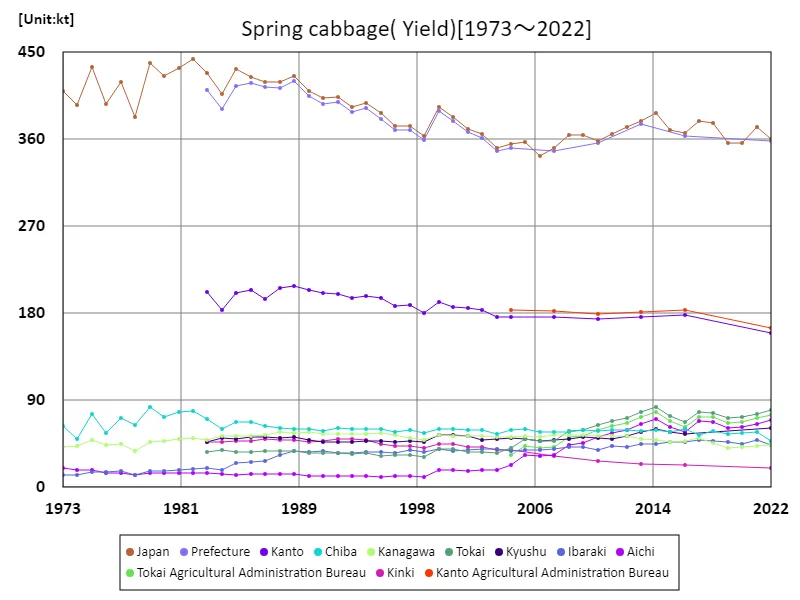

The maximum is 443kt[1982] of Japan, and the current value is about 81.3%
Spring cabbage harvest volume (by prefecture).
Looking at data for 2022 on leafy vegetable harvest volumes in Japan, Aichi Prefecture recorded the highest overall yield of 69.2kt. This is the highest yield ever and a remarkable achievement. Aichi Prefecture is taking a pioneering approach to agriculture, and it is believed that this is due to efficient production techniques and excellent quality control. On the other hand, leafy vegetable production is also active in other regions and prefectures, and each region has its own characteristics and advantages. This is due to differences in climate, soil conditions, and agricultural culture, and it is important to balance production volumes between regions. Changes in agricultural policies and demand are also having an impact, calling for the creation of sustainable production systems. Going forward, technological innovation and adaptation to market needs will be necessary, and a strategic approach that makes use of regional characteristics will be required.
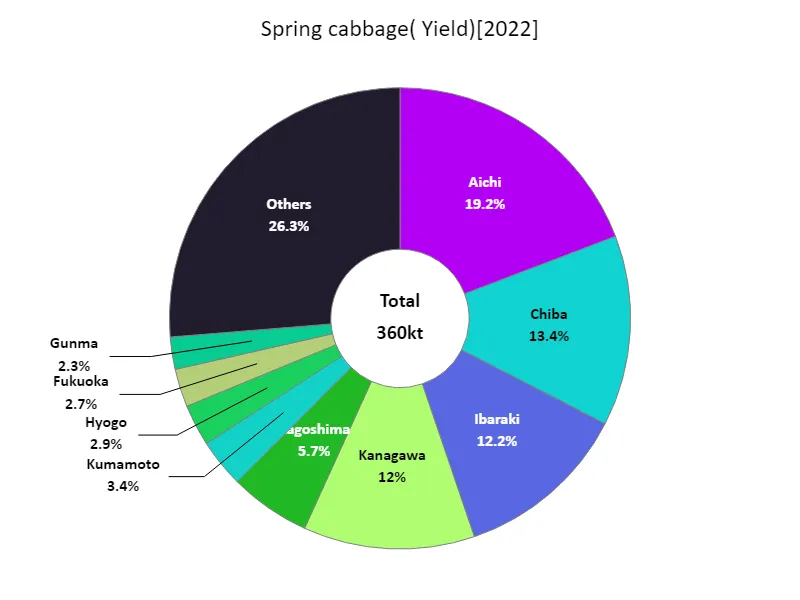

The maximum is 69.2kt of Aichi, the average is 7.67kt, and the total is 360kt
Area planted with spring cabbage (main data).
The area of land cultivated with spring cabbage in Japanese agriculture peaked at 12.8 kha nationwide in 1973, but has since declined and is currently at just 68.1% of its peak level. This decline is due to changes in agricultural structure and market demand. For example, agricultural mechanization and technological innovations that have made it possible to grow crops more efficiently may have led to a decrease in the area under cultivation. Additionally, changes in consumer eating habits and an increase in imports are also affecting the area under cultivation. Spring cabbage continues to be an important crop in Japanese agriculture, but producers and the government are undertaking various initiatives to build a sustainable agricultural production system while maintaining a balance between supply and demand. It will be necessary to continue to respond flexibly to changes in demand and technological innovations while properly managing the cultivation area of spring cabbage.
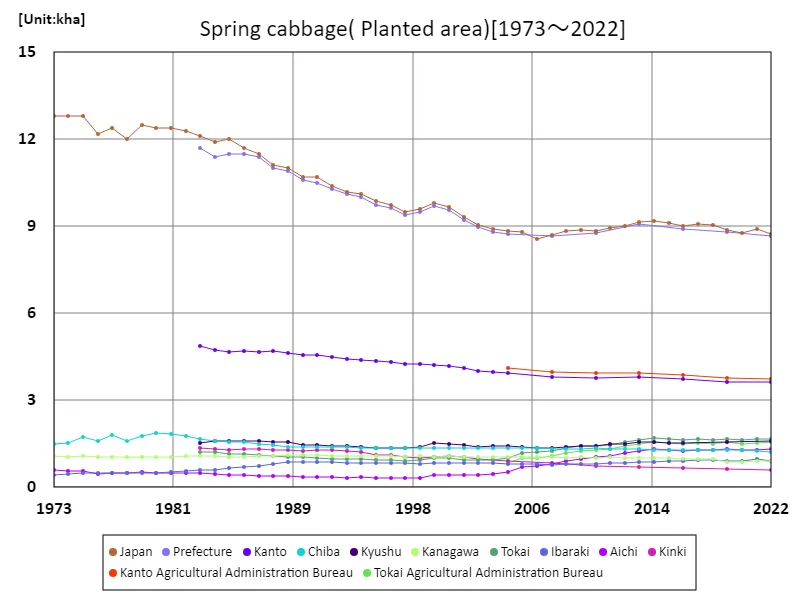

The maximum is 12.8kha[1973] of Japan, and the current value is about 68.1%
Area cultivated with spring cabbage (by prefecture).
Looking at data for 2022 regarding the area planted with leafy vegetables in Japanese agriculture, Aichi Prefecture recorded the largest area overall at 1.32 kha. This is the highest planted area ever, indicating that Aichi Prefecture is leading the way in leafy vegetable cultivation. Aichi Prefecture has introduced advanced agricultural techniques and implemented efficient agricultural management, and it is believed that these efforts have led to an increase in cultivated area. On the other hand, leafy vegetable cultivation is also popular in other regions and prefectures, and each region has its own characteristics and advantages. For example, differences in climate, soil conditions, and agricultural culture have an impact. Leafy vegetables occupy an important position in Japanese food culture, and there is a need to establish a production system that can meet demand. It is expected that more effective cultivation methods that take advantage of the characteristics of each region and improved varieties to meet market demand will continue to be developed.
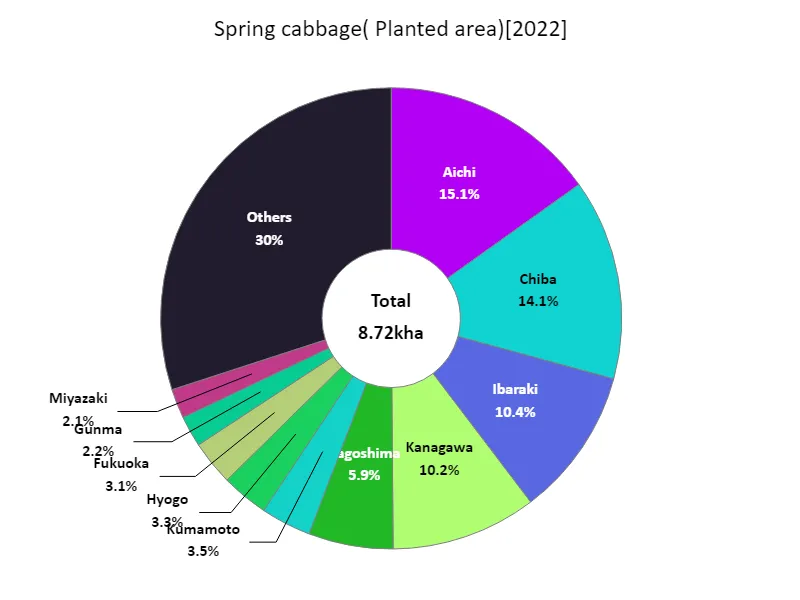

The maximum is 1.32kha of Aichi, the average is 186ha, and the total is 8.72kha
Spring cabbage shipment volume.
The volume of spring cabbage shipped in Japan in 2022 was a notable figure. The total shipping volume was 328kt, with Aichi Prefecture recording the highest volume at 65.7kt. The average shipment was 6.99kt, suggesting some regional variation. Spring cabbage shipment volumes are influenced by a variety of factors. For example, these include the climatic conditions of the production area, the technical level of farmers, and fluctuations in demand. The reason why Aichi Prefecture boasts the largest shipping volume may be due to the prefecture’s advanced agriculture and technological capabilities. Spring cabbage is one of the essential vegetables on the Japanese diet, and stable demand is also a factor in the large shipping volumes. Additionally, the development of transportation infrastructure and sales routes is also an important factor affecting shipping volume. Going forward, it will be important for agricultural producers and related organizations to continue to develop effective production and shipping plans, with an eye toward changes in demand and improvements in production efficiency.
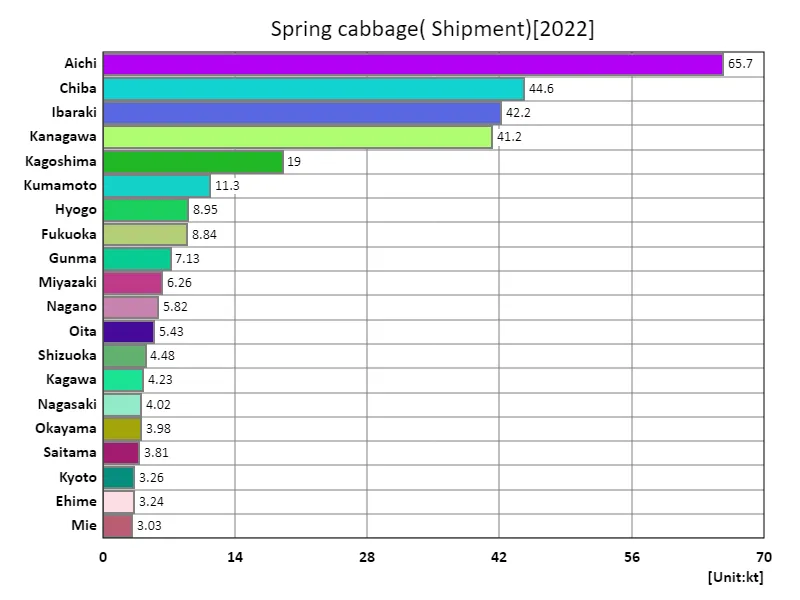

The maximum is 65.7kt of Aichi, the average is 6.99kt, and the total is 328kt
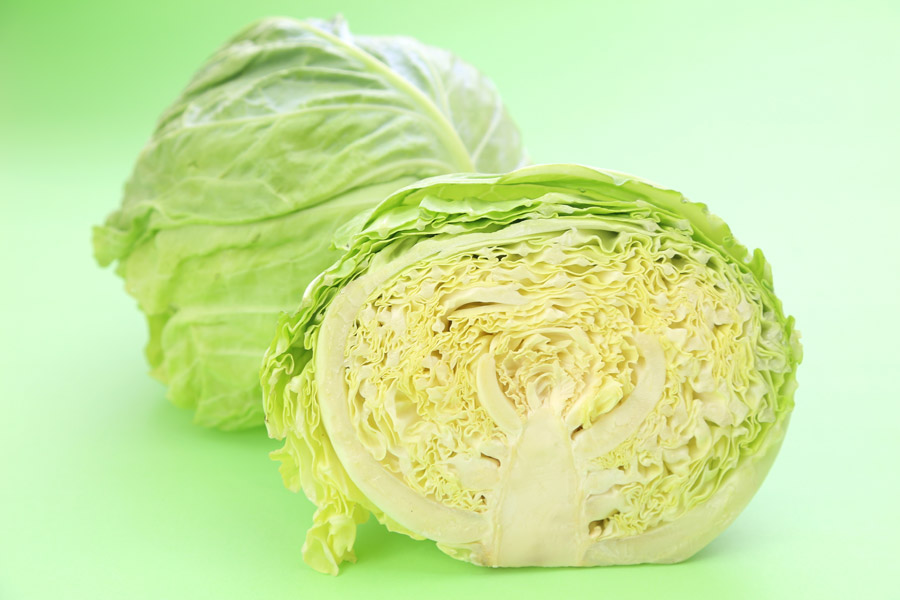


Comments